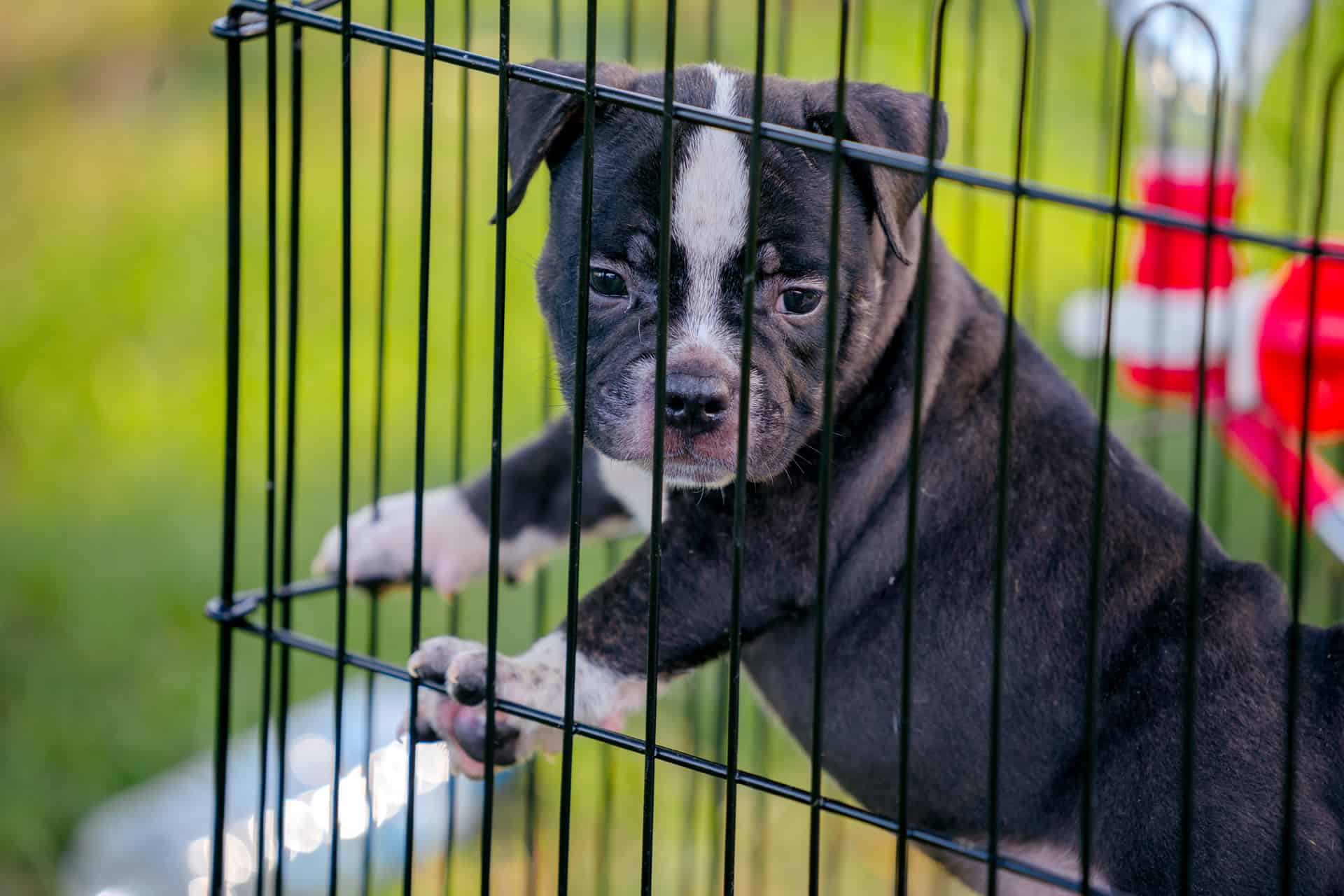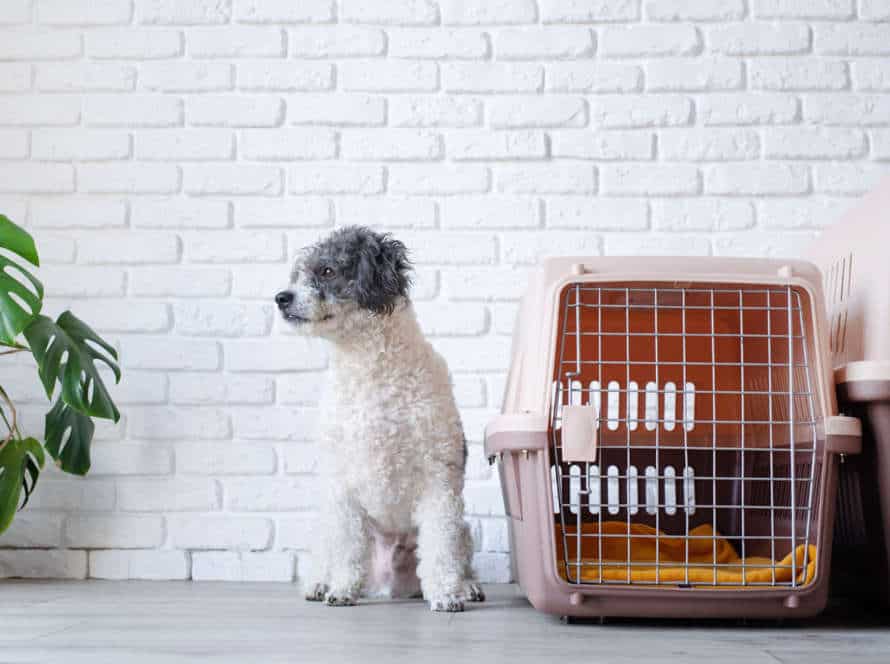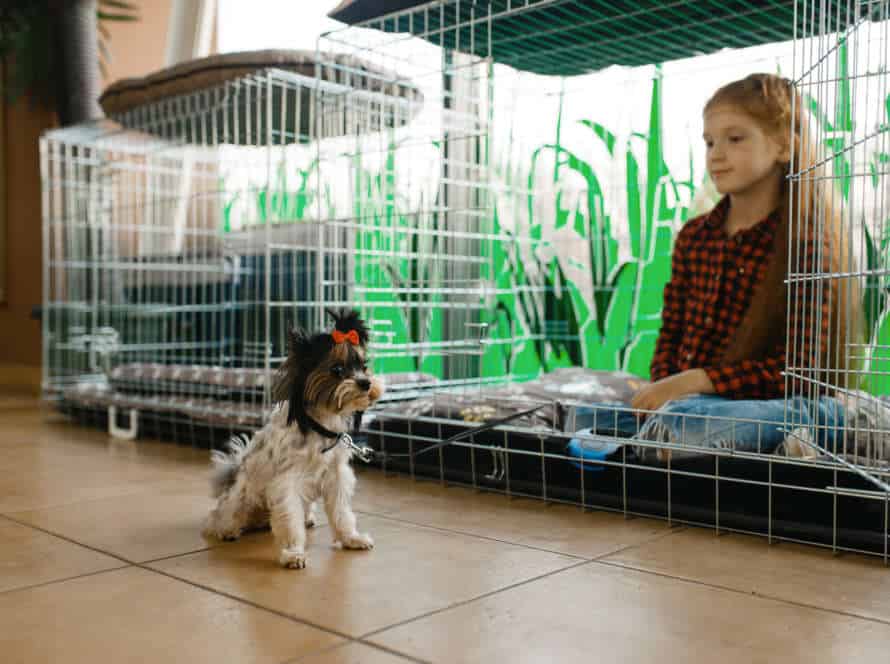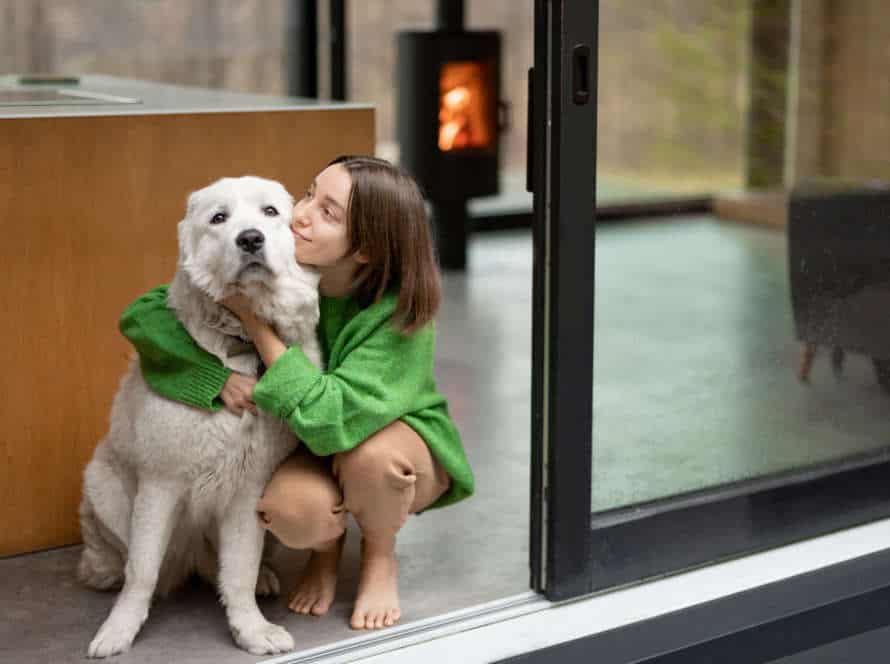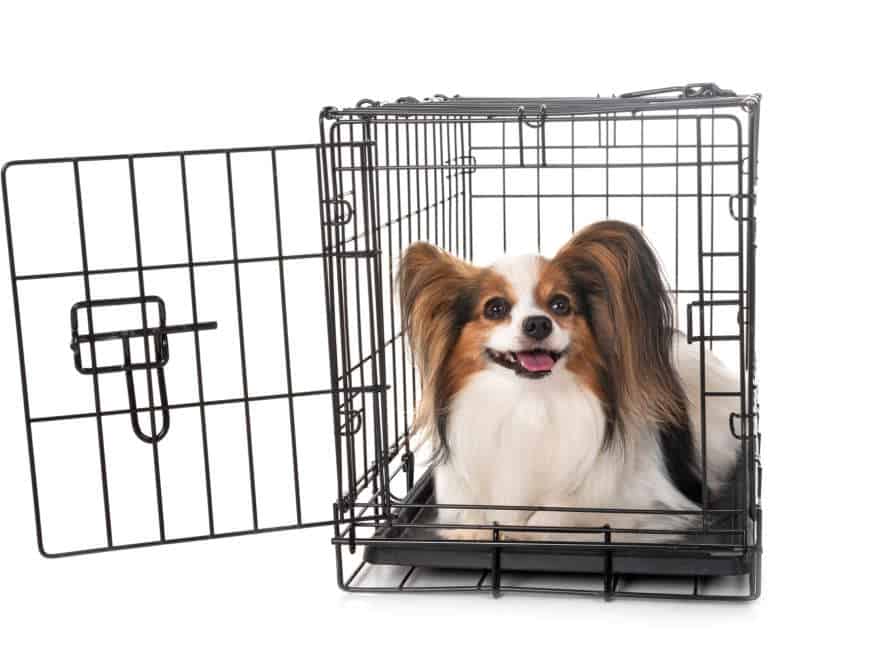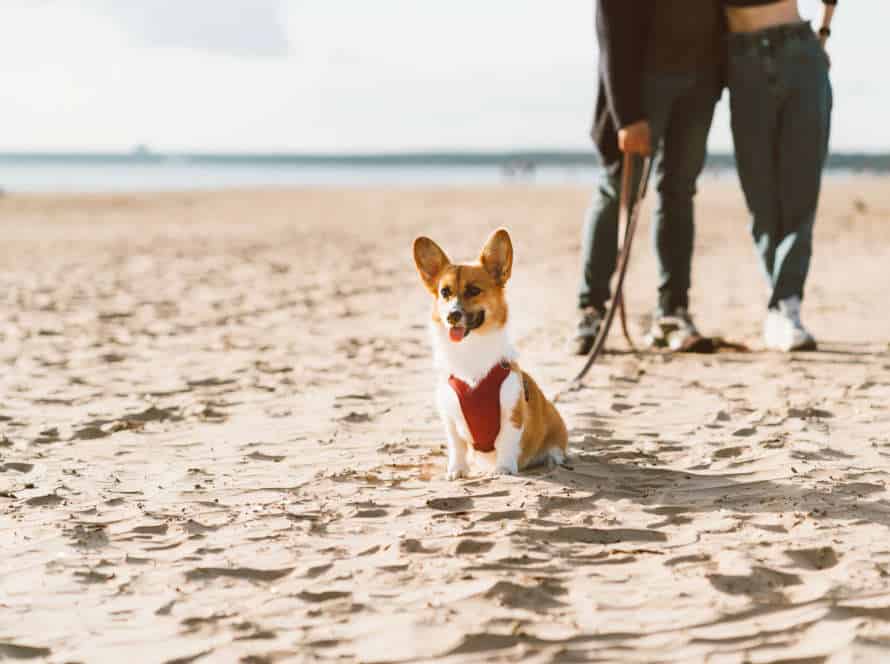Dealing with Destructive Behavior in the Crate
Dealing with destructive behavior in the crate can be tough for dog owners. Here are some tips to help:
- Make certain your pup gets plenty of playtime and exercise daily to use up energy.
- Pick a crate the right size, enough room to stretch and turn.
- Use positive reinforcement, like treats or praise, when pup is in the crate.
- Acclimate pup to crate by leaving them in it for short times and increasing the time slowly.
- If destructive behavior happens, cover the crate and give pup a chew toy to keep them busy.
Never punish pup for bad behavior in the crate, it can make the problem worse and hurt your relationship.
Understanding the Root Cause of Destructive Behavior
Pups don’t destroy crates for no cause. To mend the issue, it’s vital to comprehend why your pooch is ruining the crate. Let’s examine why destructive behavior may happen in the crate and how to take action.
Separation Anxiety
Separation anxiety in dogs is a serious problem which can lead to damaging behaviour when left alone. Signs of this could be: loud barking, chewing, digging, and even going to the toilet inside.
Understanding why this occurs is essential for managing it. One cause may be they were not socialised enough as a puppy. Another factor could be changes in their routine, like when their owners go away or go back to work.
Dealing with anxiety in the crate can be tricky. Make it a comfy area with blankets, toys, and treats. Gradual crate training can help, as can doggy daycare or a pet sitter if you’re away for a long time. Be patient with your pup and understand their anxiety. Severe cases may need professional help from a vet or animal behaviourist.
Pro tip: Always reward good behaviour and never punish for destructive actions, as this may worsen the anxiety.
Lack of Exercise and Stimulation
Lack of physical and mental activity can be the root cause of destructive behavior in dogs, especially when they are left in a crate for long. Knowing this and making efforts to stimulate your pup can help reduce such behavior.
To achieve this:
- Ensure your dog has enough exercise and stimulation throughout the day, in order to tire out their energy.
- Provide interactive toys, like puzzle feeders, to keep them busy and engaged in the crate.
- Offer your dog plenty of affection and attention to ease their fear and anxiety of being caged.
- Gradually increase the length of time they stay in the crate so they can get used to it.
Remember, destructive behavior could be a sign of bigger issues like anxiety or past trauma. Be patient with your dog and consider getting professional help if needed.
Improper Crate Training
Incorrect crate training is often the cause of bad behaviour in dogs when crated. It can lead to them feeling stressed, anxious and having a bad opinion of their crates. This can make them do bad things.
These bad things could be:
- Barking
- Whining
- Chewing the crate
- Scratching the crate
To tackle this, you can:
- Identify the reason behind the misbehaviour
- Give your dog enough exercise before crating
- Give your dog puzzle toys or chews to keep them busy
- Slowly increase their time in the crate to make them more comfortable
Pro tip: Don’t forget to use the right crate training techniques to stop bad behaviour in the future.
Addressing Separation Anxiety
Sep-anx can cause pooches to act out in the crate. This can include pacing, whining, yapping and even gnawing the crate walls. Understanding the root of the anx is step one in helping them cope. Let’s explore some solutions for your furry friend’s issue.
Gradually increasing the duration of time spent in the crate
If your pup is having separation anxiety or destructive behaviors in their crate, increasing the time they spend in it gradually is a great way to solve the issue! Here’s how:
- Start with a short 10-15 min stint, and stay nearby.
- Gradually increase the amount of time, helping them build up tolerance.
- If they act out, cut back the time, before slowly increasing again.
- Give your pup plenty of activities and toys to keep them occupied.
Addressing separation anxiety takes time and patience. But, with a gentle increase in crate time, you can help ease your pup’s stress and destructive behavior.
Leaving a favored item that smells like the owner in the crate
Separation anxiety can cause distress for pets and owners alike. When left alone, dogs may act destructively in the crate. Chewing or clawing the sides are common signs.
To soothe these anxious dogs and stop the behavior, leaving a favored item that smells like the owner in the crate is effective. Here’s how to use this technique:
- Take a piece of clothing that smells like you – t-shirt or pillowcase – and place it in the crate.
- Also, leave your dog’s favorite toys or treats in the crate for them to play with while you’re away.
Providing comfort and familiar scents helps ease their anxiety and lessen the chances of any destructive behavior in the crate.
Using supplements and calming aids
Supplements and calming aids can help with separation anxiety and the bad behavior that comes with it in dogs that live in crates. Consider these:
- CBD Oil – Studies show it can reduce stress and anxiety in dogs.
- Melatonin – Natural supplement that helps with sleep and anxiety.
- Lavender Oil – Its scent calms dogs.
- Adaptil – It is a fake pheromone that mother dogs use to relax their puppies. It can relax dogs, especially when there’s anxiety like separation anxiety.
Always speak to your vet before giving supplements or calming aids to your dog.
Pro Tip – In addition to the supplements, give your dog lots of exercise and mental stimulation to help reduce separation anxiety and destructive behavior.
Providing Adequate Exercise and Stimulation
Adequate exercise and mental stimulation are key to keeping your pup’s physical and mental health in check! Not only does it strengthen the connection between you and your furry pal, but it can also help ward off destructive behavior caused by boredom.
Let’s see how providing those activities can aid in reducing destructive behavior in the crate.
Daily exercise routine
Exercising daily is key for your pet’s physical and mental health. Plus, it stops bad behavior in the crate. Here’s a plan:
- Take a 20-minute walk morning and night.
- Give your pet toys that stimulate their brain, like puzzle feeders or chew toys.
- Play fetch or other active games with your pet.
- Look into obedience or agility classes for more challenge.
Sticking to a daily routine helps keep your pet healthy and happy, and stops them from misbehaving in the crate. Pro Tip: Consider your pet’s age, breed, and physical abilities when creating an exercise plan.
Interactive Toys
Interactive toys can be great for giving pets exercise & stimulation when in the crate. Examples are classic Kong toys or puzzle feeders to keep them busy & promote healthy eating habits. But remember, interactive toys are only supplements, not substitutes for exercise & playtime outside the crate. Also, supervise your pet when they use toys – some may be destructive & could hurt themselves or others if unattended. Rotate toys every few weeks to keep them interested & prevent boredom.
Puzzle Feeders
Puzzle feeders are great! They provide both physical and mental exercise, which can reduce destructive behavior in the crate. Your pet has to work for their food, so they stay occupied longer.
Here are some types of puzzle feeders to try:
- Treat-dispensing balls or cubes.
- Interactive feeders with compartments.
- Puzzle mats with hidden treats.
- Food puzzles with sliding pieces.
Introducing this to your pet can help them engage and release energy while in the crate. This stimulation can reduce anxiety and improve their overall behavior.
Pro tip: Start with a simple puzzle feeder and gradually make it harder as your pet becomes more experienced.
Proper Crate Training
Crate training is key to teaching your pup good behaviour. It’s essential for safety and to stop destructive habits. Let’s look at the cause of these bad behaviours first. Then, we’ll discuss how to crate train your pup properly.
Getting the Right Size Crate
Selecting the proper crate size is critical for successful crate training. If the crate is too small, it can cause distress and lead to destruction. If it’s too big, your pup may use one end as a potty and the other end to sleep. Here are some tips:
- Measure your pup’s height and length, and add 2-4 inches for space.
- For pups, factor in their adult size.
- Ensure the crate has enough headroom for them to stand and turn around easily.
- Get a crate with adjustable dividers for growth.
The right size crate will make crate training easier and prevent destruction.
Using Positive Reinforcement Techniques
Positive reinforcement is key to successful crate training, reducing destructive behavior in pups. Here are the techniques to use:
- Rewards; offer treats, toys or praise when your dog happily enters the crate.
- Introduce it slowly; start with short periods and gradually increase the time they spend in the crate.
- Comfort; make the crate comfortable and cozy to encourage usage.
- Consistency; stick to a routine for feeding, exercise and potty breaks.
- Patience; be patient and don’t punish your pup. Instead, reward positive behaviors.
Positive reinforcement techniques work best when you’re patient, consistent and understand your pup’s individual needs.
Avoiding Punishment or Yelling
Don’t punish or shout at your pup during crate training – it can form negative connections and lead to bad behavior. Here are some tips for proper crate training and handling destructive behavior in the crate:
- Gradually introduce the crate to your pooch, letting them explore it and making positive associations with snacks and commendation.
- Use positive reinforcement methods, like giving your pup a reward for entering the crate on their own or staying quietly inside.
- Begin with short periods of time in the crate. Making the crate comfy and secure could stop destructive behavior.
- If your dog displays destructive behavior, like gnawing or clawing, don’t yell or punish them. Instead, calmly disrupt the behavior and redirect their attention to a chew toy or treat.
By using positive reinforcement methods and avoiding punishment or shouting, you can successfully crate train your pup and stop destructive behavior.
Managing Destructive Behavior
Dealing with destructive pup behavior in the crate? It’s vital to set boundaries and expectations. To ensure your pup knows what you expect, consistency strategies may be needed. Also, socializing and providing physical and mental exercise are essential. Let’s discuss the strategies for managing destructive behavior further.
Using a crate cover
Utilizing a crate cover is a helpful way to manage destructive behavior in pooches who spend time in a crate. Here are the benefits:
- Gives a sense of privacy & security, lessening anxiety & stopping destruction.
- Limits external stimuli like loud noises or visual interruptions that can make your pup anxious or over-excited.
- Makes a darker, more den-like environment that can aid your dog to relax & sleep better.
When selecting a crate cover, ensure it is of breathable material to ensure proper ventilation & air flow. You may also use a dark-colored towel or blanket as an alternative to a specifically designed cover.
Pro tip: Supervise your pup when introducing the new cover to make sure they don’t chew on it or become overly anxious.
Using deterrent sprays
Deterrent sprays are great for controlling naughty doggo behavior when it comes to crate training. They make items in the crate taste bad or smell yucky, to stop biting and chewing. Here’s how to use them right:
- Pick a spray designed for doggos, check ingredients are safe and non-toxic.
- Clean and dry the crate before spraying.
- Spray the spots where your pup chews or bites.
- Keep an eye on them and reapply as needed.
Pro tip: Deterrent sprays can help with training, but you need to find the underlying cause of the bad behavior, so it doesn’t become a habit.
Seeking professional help if necessary
Dealing with destructive behavior in the crate can be so annoying! Seeking professional help is sometimes a must, to manage and fix the behavior.
Here are some reasons why you need to look for help:
- If your pup’s bad behavior won’t go away.
- If they get anxious or mad when you try to put them in the crate.
- If they act aggressively when in the crate.
- If their destructive behavior seems to be due to a bigger issue, like separation anxiety or fear.
A professional dog trainer or behaviorist can figure out why your pup has bad behavior and create a plan to improve it. It’s important to take action quickly, for their safety and others.
Frequently Asked Questions
Q: Why is my dog destructive in the crate?
A: There can be a variety of reasons why a dog is destructive in the crate, including anxiety, boredom, or lack of exercise.
Q: How can I prevent destructive behavior in the crate?
A: Providing ample exercise and mental stimulation, as well as making the crate a comfortable and safe space, can help prevent destructive behavior. Gradually increasing the amount of time spent in the crate can also help the dog become more comfortable.
Q: Should I punish my dog for being destructive in the crate?
A: No, punishment is not a recommended method for preventing destructive behavior in the crate. It can increase anxiety and fear, and worsen the behavior. Instead, focus on positive reinforcement and providing a comfortable and safe environment.
Q: Can I leave my dog in the crate all day?
A: No, it is not recommended to leave a dog in the crate for extended periods of time. Dogs need exercise, socialization, and stimulation, and being confined for long periods can lead to boredom and anxiety.
Q: Should I use a crate as punishment?
A: No, using a crate as punishment can create negative associations with being in the crate and worsen destructive behavior. The crate should be a comfortable and safe space for the dog.
Q: Can I leave toys and treats in the crate?
A: Yes, leaving toys and treats in the crate can help provide mental stimulation and make it a more positive place for the dog. However, be sure to not leave anything that the dog can choke on or ingest.

